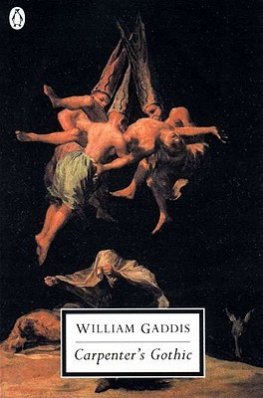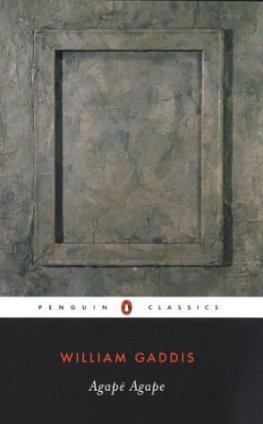
THE LETTERS OF
WILLIAM GADDIS
Edited by Steven Moore
with an Afterword by Sarah Gaddis

CONTENTS
p. 14: WG at Merricourt, c. 1928
p. 17: WG in the Caribbean, 1940
p. 17: Edith Gaddis, 1941
p. 27: WG in Arizona, 1942
p. 54: WG at Harvard, 1944
p. 75: WG and Ormonde de Kay, late 1940s
p. 111: WG sailing for Spain, 1948
p. 138: WG and Eulalio Abril Morales, 1949
p. 151: WG and Margaret Williams in Paris, 1950
p. 164: WG in Spain, 1950 and 1951
p. 197: WG back in the USA, 1951
p. 198: WG, Margaret Williams, Charles Eagan, and Kathleen Costello, 1951
p. 207: Sheri Martinelli
p. 220: WG, 1955
p. 229: WG with wife Pat and children, 1955 and 1958
p. 238: WG and David Markson, 1964
p. 238: Edith Gaddis at Massapequa, early 1960s
p. 252: WG in Germany, 1964
p. 259: WG on Fire Island, mid 1960s
p. 261: WG and Judith Gaddis, late 1960s
p. 277: WG and Judith in Ganja and Hess, 1972
p. 324: WGs carpenter gothic house
p. 360: WG and Muriel Oxenberg Murphy, 1980
p. 398: WG and Frederick Exley, 1983
p. 398: WG with John Sherry and Donn Pennebaker, 1995
p. 425: WG with Mario Vargas Llosa and William H. Gass, 1986
p. 425: WG and Steven Moore, 1987
p. 430: WG with Sarah Gaddis in Paris, 1985
p. 430: WG in Paris, 1988
p. 445: WG with Donald Barthelme and Walter Abish, 1987
p. 524: WGs house on Boat Yard Road
p. 524: WG with Saul Steinberg and Judith Gaddis, 1997
p. 526: WG with Matthew and Sarah Gaddis, Key West, 1998
Its hard to say whether William Gaddis would have approved of this book, hard to judge whether he was serious or joking when he wrote to his mother in 1949 to state, Our correspondence should never be published. Publically, he insisted that only a writers published work matters and the rest is not our business (as his revered T. S. Eliot wrote); he submitted to interviews reluctantlyand not until the second half of his careergave no readings, and regarded biographical details as irrelevant. He planted his views early in his first novel, The Recognitions (1955), and thereafter directed inquiring critics and interviewers to reread this passage: What is it they want from a man that they didnt get from his work? the reclusive painter Wyatt Gwyon asks his wife Esther. What do they expect? What is there left of him when hes done his work? Whats any artist, but the dregs of his work? the human shambles that follows it around. Whats left of the man when the works done but a shambles of apology (9596). He reiterated the point twenty years later in his second novel, J R (1975): when Rhoda, the teenage squatter at the 96th Street apartment, tells the composer Edward Bast that hes not very interesting, he sputters, Well why should I be interesting! I mean, I mean I want my work to be interesting but why do I have to be interesting! I mean everybodys trying to be interesting let them Im just, Im just doing something I have to do... (561). Gaddis admired Justice Oliver Wendell Holmes for ordering all his papers burnt & letting his Opinions stand for themselves nobodys business how he got there, as he writes in one of the letters in this volume, and in another marveled at Faulkners ambition to be, as a private individual, abolished and voided from history, leaving it markless, no refuse save for the printed books. I can imagine what he would think of strangers reading his mail.
And yet, he did not burn his papers. As essays, PhD theses, and then books on his work began to appear, Gaddis resigned himself to becoming the subject of a biography someday and to seeing his letters published after his death. He addressed the latter threat (as he called it) in the letters themselves; when I wrote to him in 1984 requesting permission to view some letters held by the Bruce Peel Special Collections Library (University of Alberta), he reluctantly granted permission, although as youre surely aware its an entire area Ive never condoned. Some of my reasons have been noted in relation to my reticence re interviews though here they go further: like many fledglings, my early letters were many times written with the vain notion of eventual publication & thus obviously much embarrassing nonsense; & of the later ones, those of substance will probably never be seen for equally fortunate if exactly different reasons. (I dont know if you happened upon a review of Hemingways letters by Hugh Kenner, might have been in that same Harpers with my piece 2 or 3 years ago, but he does use them to flay the writer & point up frailties in his work as glimpses of the real Hemingway, I think really these things go quite the opposite, the letters are the detritus &c).
Later that year, when I was stepping up my efforts to collect Gaddiss lettersboth for my own work and to secure those to former friends and contacts while they were still accessiblehe snapped no ones [letters] are written for publication (unless they are in which case theyre probably full of lies).
Privately, however, he maintained his archives over the years and near the end of his life carefully prepared them for eventual sale to a university library, telling his children that he relished the idea of scholars poring over his papers and making all sorts of discoveries. At any rate, his letters are neither full of lies nor the mere detritus of his life; they do indeed offer glimpses of the real Gaddis, and rather than providing the means to flay the writer & point up frailties in his work, they foster a deeper appreciation of the writer and his work.
Its ironic that Gaddis complainedin a 1948 letter to his mother after reading about dramatist Eugenes ONeills early vagabond daysthat he was furious that one can no longer live as he didjust wandering about, one job, one ship to another, for Gaddis led what sounds today like an almost mythic young writers life. Born near the beginning of the Roaring Twenties (29 December 1922), he went off to boarding school at age five, learning to negotiate the trains between Manhattan and Berlin, Connecticut, and writing numerous poems while still a child. In high school he contracted a rare tropical disease that baffled his doctors and kept him home from school for a year and a half. During the summer before his senior year, he sailed to the Caribbean and visited Haiti and Venezuela, and in 1941 was accepted by the only college he applied to, but had to leave Harvard after a few months because of complications resulting from his earlier treatment. He sailed through the Panama Canal (the week the Japanese bombed Pearl Harbor) to California and stayed at a ranch in Arizona for a few months, wrangling horses and hitchhiking through the southwest before driving an old woman and her mentally unstable son to St. Louis, where he spent a month and a half living on a government ship on the Mississippi River building a pipeline for a dredge in big hip boots, then went back west to celebrate Cheyennes Frontier Days with enough gusto to get thrown in jail, then headed down to Colorado to work at a mine near Leadville before returning to Harvard in the fall of 42, a few months before his twentieth birthday.
There he became president of the Harvard Lampoon, but after a minor public disturbance (drunk and disorderly) that wouldnt raise an eyebrow today, he was asked to leave Harvard in January 1945. He quickly snagged a job as a fact-checker at the New Yorker and lived in Greenwich Village (at the same address where Wyatt Gwyon forges his paintings), writing stories and raising hell until the spring of 1947, when he and a friend drove down to Mexico in a Cord convertible, an adventure recounted in a long letter (9 March 1947) that reads like a comic outtake from Jack Kerouacs
Next page











